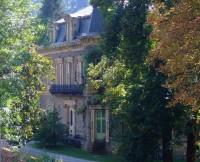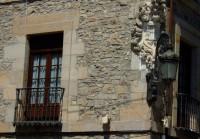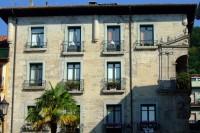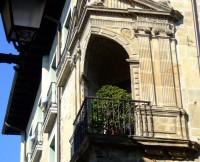I can hardly think of Vergara without at once evoking the strange expression used by Valle-Inclán–one of my favourite Spanish writers– to refer to the historical events that took place in such town. I used to think of these words as coming wrapped in some kind of mistery within the misterious Spanish side-wars called Carlistas. “The betrayal of Vergara”, wrote Valle-Inclán. What betrayal was that? I guessed it must be connected with the agreement of Vergara, but what did the writer exactly mean? Thus, this time I took a ride there for learning about those facts in situ, rather than for just the pleasure of riding.

The village of Vergara
Besides, the day comes perfect for the motorcycle: warm, sunny and not windy. Wonderful for a biker. The first half of the ride, until Escoriaza, goes on a pleasurable pavement and along fun bends, great for testing one’s ability; but the second half isn’t that nice, running through the industrial areas of Arechabaleta and Arrasate.
Before almost realizing it, I’m already crossing over the Deva river and arriving to the city centre of Vergara, right by the old town. It’s past noon, and becoming a bit hot. I park Rosaura well in the shade and start a stroll along the town. By pure chance, the first thing calling my attention is the corner-crest of the sober Irizar palace, precisely the house where generals Maroto and Espartero signed the famous agreement which, in 1839, ended the first Carlista war.

Corner-crest on Irizar palace.
But supposedly I still don’t know about that; so, I walk to the palace attracted, as usual, by the solemn beauty of ancient buildings. The double-leaf gate is open, and across it there is a smal yard, cobbled, holding a succint exhibition where the history of the building is told on big posters, and the circumstances under which the agreement and the embrace of Vergara took place are explained. I pick the last brochure in Spanish (the copies in Basque sleep in their box, evidencing that a bilingual Basque country is more a wish than a reality) and, while sauntering along the borough, I read the events that made a historical landmark of it. Tough task, though, as the brochure tries to harmonize historical accuracy and independentist dogmatism, thus being tepid and barely informative.

Irizar palace, where the agreement was signed.
A couple of blocks further, I run into a wide square having on one side the excessively emblazoned city hall and, on the other, one of Vergara’s most important and historically relevant buildings: the Royal seminar, seat of the Royal Basque society of friends of the land, formerly a school belonging to the religious order Compañía de Jesús, thrown out from Spain by the king.

City hall, showing many flags for cloaking the Spanish one. Behind it, the church bell tower.
Thi seminar was founded during the splendour of Vergara, after the end of the struggles which, for two centuries, upheaved the town, having confronted rival families and neighbourhoods. Along with the peace, prosperity came and stayed between XVIth and XVIIIth centuries, firstly as an agricultural market, then as an industrial settlement and, finally, thanks to the seminar, as a cultural centre. It was here where the chemical element Wolframium was discovered.

Royal seminar. Presently seat of a University.
Right behind the city hall stands, majestic and sturdy, the ancient parish of San Pedro de Ariznoa, the real germ of Vergara. Indeed, little more than a chapel must have existed in these whereabouts before Alfonso X, in the year 1268, decreed the foundation of a borough, with privileges alike those of Vitoria and named Villanueva (of Vergara). Thus reads the document:
“…We must create a borough in Vergara, namely in such a place called Ariznoa, and We name it Villanueva, and in order to do good and favour to the present and to-be settlers, we grant them the same privileges as those of Vitoria.”
Upcoming kings added new privileges to the borough for achieving a faster populating.
Thus, and like other Basque towns, Vergara was born under the rule of Castile, and to Castile only (except later to Spain) has it ever belonged along History. Therefore, there are no grounds whatsoever for being included in the territory that, today, claims their independence upon historical basis. (Mark, btw, that Vergara has always been written as such: with V, and that the present official name of Bergara, with B, has the sole political purpose of artificially “Basqu-izing” it.)

Parish of San Pedro de Ariznoa, germ of Vergara.
I watch the parish from outside and, despite the elegance of its South facade, coat of arms and all, I like better its West side portico (once main entrance), with its romantic medieval look bestowed by the shades, the wood posts and the worn steps. Yet, I like even better the narrow, wet and cool porched alley of the North side. And walking along this side I find a by-door leading to the church’s gloomy inside.

San Pedro’s west portico.
Inside San Pedro of Ariznoa.
Such black opening seems to attract me with a force that I can’t resist. Obedient, full of curiosity and awe, I stealthily set foot inside the blackness as if crossing the threshold to another world. Once in, I face total darkness, which my eyes need some time to pierce through. When the thick shadows thin out a bit, I see that I’m within a side nave, only a few feet away from the main one. Some metres to my left, in the middle of the shapeless nothingness, there is the milky rectangle of a door ajar leading somewhere, maybe to the vestry. Right ahead of me, the main nave’s vault appears soaked in a dim greyish light, quite faint, whose origin I can’t tell. To my right, shielded from any light whatsoever by the choir’s floor above and one of the church’s thick pillars, there are a few benches submerged in the thickest blackness. Slowly and carefully, I grope my way along and sit on a bench. Upon feeling my weight, a creak of the wood fills in the utter silence.
¿Utter? Not quite. As my eyes and ears get used to this gloom and quietness, I start perceiving a faint, constant murmur and a some feeble chance whispers. Now and then, I see noiseless figures moving in the shade. In front of the altar, a kneeling body under a robe bowes once in a while. Thence the murmur. And the whispers? They’re the rustle of the habits of angelic-looking beings which go about barely touching the floor, apparently footstepsless, moving back and forth as puppets whose threads came down from up the dome. I see them getting in or out through the vestry door, and performing various tasks in complete silence: change the flowers, dust the altarpiece, fill in the holy water basins. Or they come in, or leave, through the same gate I used.
I feel as a time-traveler, watching scenes of the past from within an invisible bubble. Then, I fancy that one of those figures lifts her face and stares at me, as if she could pierce the blackness’ opacity whereof I’m wrapped up. She’s a young woman, graceful, maybe even pretty. Then she goes back to her job, whichever it is.
I remain sitting here for a while, enjoying a spiritual composure, safe from the dangers and worries of the outer world. It’s like if I had entered an enchanted place, where peace, silence and shadows dwell, and I feel part of such place, blended with the wood and the stone. An almost mystic experience.
When I come out to life and light, I try to follow the track of one of those angels. Along the way, I run into another one, which throws at me a quick glance and a faint smile. She’s also young. They can’t possibly be nuns. Maybe lay sisters? Nearby there is the ancient monastery of the Holy Trinity, where the Clarisas sisters abide.

Monastery of the Holy Trinity. Clarisas.
A thorough tour along the old town’s streets gives me the chance of beholding plenty of noblemens’ emblazoned palaces, elegant and even luxurious, evidencing that the grant of privileges to the noblemen for settling in Vergara was quite effective for populating the village.
-

- Palacio de Unzueta
-

- Casa de Izaguirre Moya
-

- Palacio de Arrese
-

- Balcón en esquina. Palacio de Arrese
Unlike other medieval boroughs founded during the same time and with similar purposes (border strenghten and commerce expansion), Vergara was never walled up–which doesn’t mean it was a peaceful town: along XIVth and XVth, frays were fought continually on the streets out of a long faction war, held between districts and, oftentimes–like Shakespeare’s Capulets and Montagues–between families, namely the Ozaetas and the Gabirias.
With the energy of a kid visiting a castle for the first time, I climb up the steep backstreets which lead to the ancient Nunnery of La Soledad, from where you can look out over the whole village’s roofs and Deva’s riverbed. Right in front of the nunnery’s facade there is a grass patch under a leafy tree, where I take a little rest, as I’m no kid any more. What an idyllic place! Like many other in the Basque country, it seems to have got tangled in the thorns of time…

Ancient nunnery of La Soledad.
Then, I go down from here to the cool and wooded Deva bank–first taking a look at Rosaura, who waits for me sound safe in the shade. From one of the Deva’s bridges I can see, contrasting with the woody background, the Santa Marina parish, witness of the famous embrace between the two confronted armies.

Deva river and Santa Marina parish.
I head that way with the aim of treading with my own feet on that meeting’s–or that betrayal’s scene.
Indeed, during the first of XIXth century, Vergara’s prosperity, evidenced by the many rich palaces and buildings, was hampered when the town got involved in the Carlistas wars and became main scene for some of its events. History goes that, after Fernando the VIIth’s death, this region was split between liberals (supporting his regent widow Cristina) and the carlistas (backing up his brother, prince Carlos). Vergara was first loyal to the former, but soon surrendered to the latter without resistance, and passed under the command of General Maroto. However, as liberals were moving forward in other fronts and as hunger, disease, floods and other calamities fell upon Vergara, it was deemed convenient to reach some agreement to put an end to such fratricidal war. To this end, conversations started between both armies’ Generals, who finally agreed on the aforementioned agreement, hereby carlistas must reverse their weapons under condition that the Crown would respect their privileges, which the regent wanted to revoke. And this agreement, after having been signed in the Irizar palace as told, was publicly sealed and “dramatized” by both generals embracing each other on the outskirts of town, beside Santa Marina church.

Deva river by the “field of embrace”, to the left.
And this is the pact to which Valle-Inclán, or maybe just one of his characters, refers to as the betrayal of Vergara, in the belief that the Carlista cause was thereby treasoned. So, thanks to this tour, the mystery has finally vanished around the writer’s words, for me. Mission accomplished, I needn’t but go back home. Not before having my customary drink and pincho in some pleasant bar, though. Aróstegui house is the place, where I wolf down the pincho de tortilla while drinking a coke sitting at a table under a leafy tree in the sleepy afternoon.

Laureaga palace.
On the field of embrace’s West end stands a palace now owned by Laureaga lineage, but built by the Izaguirres during XVIth century, who set that on the bars of its lower window this inscription should be engraved: “Neither seek it nor dread it”; meaning death. Wise motto to live by, if you’re able to.









